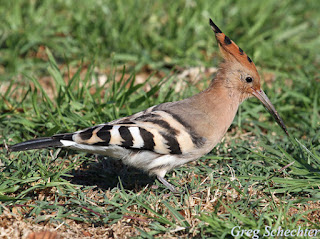The Hoopoe, scientifically known as Upupa epops, is a unique bird as it is the sole living member of its family, Upupidae. It belongs to a distinct taxonomic hierarchy and has a widespread distribution across Africa, Asia, and Europe. Despite facing challenges such as habitat degradation and climate change, the Hoopoe remains resilient and is currently classified as a species of Least Concern by the International Union for Conservation of Nature (IUCN).
Taxonomic Classification
- Kingdom: Animalia
- Phylum: Chordata
- Class: Aves
- Order: Bucerotiformes
- Family: Upupidae
- Genus: Upupa
- Species:Upupa epops
Distribution and Status
The Hoopoe can be found in diverse regions worldwide, including Africa, Asia, and Europe. Although it faces threats like habitat degradation and climate change, the IUCN lists it as a species of Least Concern, indicating that while localized declines may occur, the overall population remains stable, with an estimated 5-10 million individuals globally.
Distinctive Traits and Behaviors
- Name of Young: Hoopoe chicks or hatchlings.
- Group Behavior: Primarily solitary birds.
- Most Distinctive Feature: A crest of feathers on the head.
- Wingspan: Ranges from 44 cm to 48 cm (17 in – 19 in).
- Habitat: Inhabits forests, plains, and savannas.
- Diet: Omnivorous, feeding on ants, grasshoppers, beetles, crickets, and other insects.
- Lifespan: Typically around 10 years in the wild.
- Weight: Between 46 g to 89 g (1.6 oz – 3.1 oz).
- Length: Ranges from 25 cm to 32 cm (10 in – 12.6 in).
- Age of Sexual Maturity: Reaches sexual maturity within a few months after hatching.
Notable Facts
Cultural Significance: The Hoopoe appears in various cultural texts and myths, symbolizing wisdom, beauty, and guidance. It is also the national bird of Israel.
Sunbathing Behavior: Known to spread out on the ground to sunbathe, a behavior that helps with temperature regulation and preening.
Defensive Mechanism: Can emit foul-smelling chemicals to deter predators.
Tolerance of Humans: Often indifferent to human presence while feeding.
Scientific Name
The Hoopoe, under the genus *Upupa*, derives its name from its distinctive vocalization. Its classification within the order Coraciiformes highlights its evolutionary distinctiveness and relationship with other species in the order.
Evolution
Paleontological discoveries, despite being scarce, provide valuable insights into the evolutionary history of the Hoopoe and its relatives. Each finding contributes to understanding how these birds evolved over millions of years.
Types
The African and Madagascan Hoopoes have diverged from the Eurasian Hoopoe, showcasing genetic and morphological differences. The potential extinction of the Saint Helena Hoopoe highlights the fragility of biodiversity and the impact of human activities.
Appearance and Behavior
The Hoopoe's striking appearance, with its vibrant crest and black-and-white striped wings, sets it apart. Its flapping style, feeding habits, and defensive adaptations showcase its adaptability. The solitary bird exhibits complex behaviors during mating and territorial disputes, and its seasonal movements demonstrate adaptability to changing environments.
Habitat
The Hoopoe's wide range across Eurasia and Africa reflects its adaptability to various habitats, from forests to savannahs and grasslands. It prefers open spaces with sparse vegetation and suitable nesting sites like crevices in cliffs or walls.
Diet
The Hoopoe's diet includes spiders, small lizards, frogs, and primarily insects such as beetles, cicadas, and crickets. It uses its strong beak to probe the ground for insects and can catch flying insects on the wing, showcasing its versatility in hunting techniques.
Predators and Threats
The Hoopoe has few natural predators and plays a beneficial role in pest control. Human activities such as hunting and habitat loss can pose threats, particularly to certain subspecies. Conservation efforts focus on mitigating these threats and preserving habitats.
Reproduction, Babies, and Lifespan
The Hoopoe exhibits monogamous mating behavior, with males offering insects as gifts during courtship. Females invest in egg production and incubation, while males provide food. The secretion of noxious substances by females and chicks serves as a defense mechanism. Chicks develop from fluffy down to full feathering, and Hoopoes typically live around 10 years in the wild.
Population
With an estimated global population of five to ten million individuals, the Hoopoe is classified as least concern on the IUCN Red List. While the overall population trend is stable, localized pressures can affect different subspecies. Conservation strategies focus on addressing specific threats to ensure the long-term survival of Hoopoe populations.
Conclusion
The Hoopoe is a fascinating bird with a striking appearance, intricate behaviors, and significant ecological importance. Its widespread distribution, diverse diet, and unique reproductive strategies underscore its resilience across Eurasia and Africa. While facing localized pressures, Hoopoe populations overall remain robust. Continued conservation efforts are essential for ensuring the long-term survival of this charismatic avian species.







